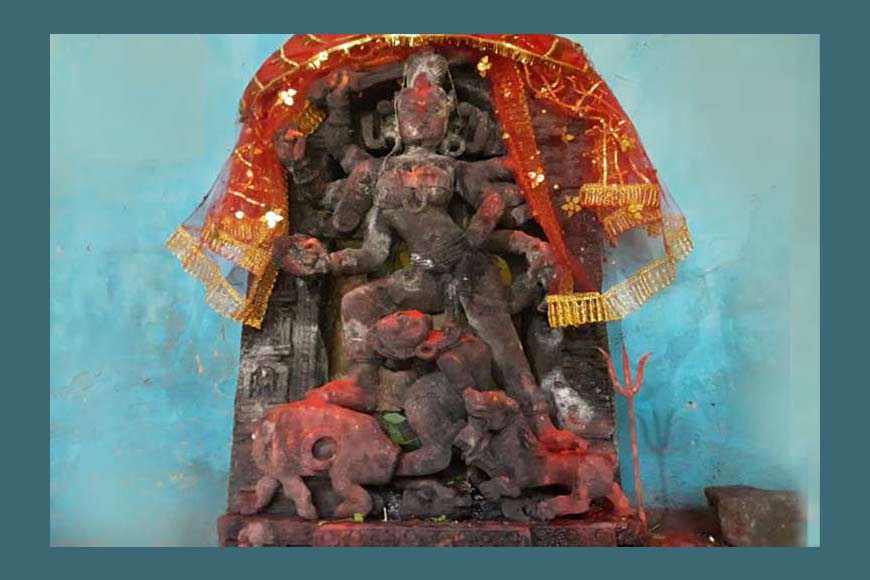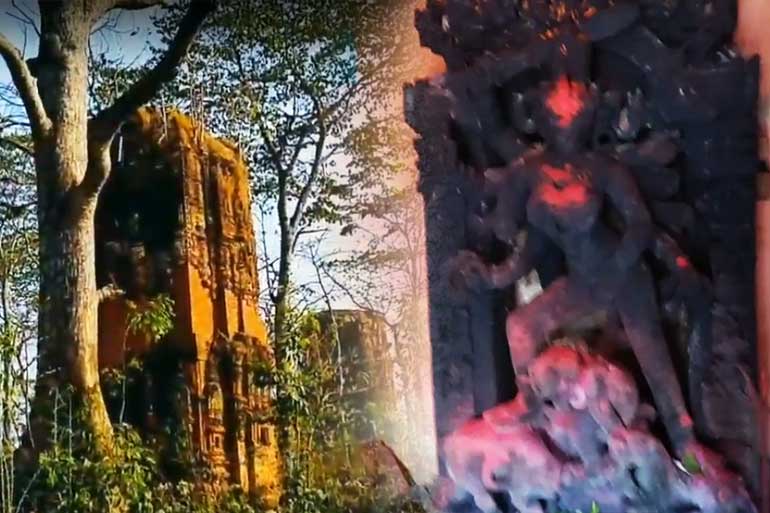Century-old Durga Puja of Purulia’s Deulghata - GetBengal story

Deulghata Durga Puja, Purulia
Purulia is famous for many things such as the Chau dance, the Masks of Charida village which are used in the martial dance of Chau, its rich biodiversity, and so on. Along with all this, it is also distinguished for hosting the country's most ancient Durga Puja celebration. Within this tradition, the idol or the Matri Murti takes on a distinct and unique manifestation of Goddess Durga. Unlike the customary yellow or flesh-toned depictions, the goddess is cast in a striking black hue, adding a remarkable twist to her timeless form.
The first mention of the Deulghata temple is found in the writings of the commissioner of Chota Nagpur, Lieutenant Colonel E.T Dalton’s “Notes on a Tour in Manbhoom in 1864-65”. He wrote that there were 3 temples in Deulghata but one of them collapsed in the year 2002. Among the 3 temples, the height of the tallest temple was 10 feet and this temple was the one that collapsed. He wrote about the Deulghata temple in Purulia and admired the architecture of the temple. All the temples are east-facing, standing on the banks of the river Kansabati. The Kansabati river is 27 km away from the city of Purulia. Deulghata literally means “Land of Temples.” One can still find two temples built during the 10th – 12th century when local kings patronised Jainism. The other areas that still have evidence of that era are Telkupi, Pakbira, Para and Banda. As the temples were built under Ananthavarman Chodaganga Deva’s patronage who also built Jagannath temple and Konark temple, the architecture was too similar to Rekha (straight) Deul (temple) style. The Rekha-Deul-style temples look like a Shikara (mountain peak). It has a sanctum or Garvagriha with a tower-shaped cover called Shikara.

From Kolkata, Deulghata temples are at a distance of 280 kilometres and the driving time is close to seven hours. In Deulghata, an area covered with greenery, there is the 2000-year-old Durga Mandir. Within the hallowed confines of this sacred shrine, the divine Goddess Durga finds her abode, surrounded by walls steeped in the timeless artistry of terracotta. The temple itself stands as a testament to architectural splendour and enduring spirituality, offering visitors a profound glimpse into a rich and ancient heritage that has withstood the test of time. This sacred relic stands as a testament to the deep-rooted history that courses through Purulia's veins, where every nook and cranny whispers stories of a bygone era, etching the past into the very soul of this remarkable place.
Crafted in the architectural likeness of Buddhist temples, this historic sanctuary traces its origins to the illustrious Pala dynasty. Adorned with remarkable stone sculptures, the temple's entrance takes a distinctive triangular form. These intricate details serve as a testament to its magnificent and storied past, echoing the resplendent history that envelops this sacred site.
The deity enshrined within deviates from the conventional portrayal of Goddess Durga. Her complexion is a deep black hue, a departure from the norm. Unlike the typical depiction where the goddess's left foot rests upon a buffalo, here, it's her right foot that gracefully treads upon the sacred creature. Crowning her divine form is the emblematic chakra pillar, while beneath her feet, ethereal fairy figurines grace the sacred ground. Flanking the mother goddess on either side are embodiments of the Ashta Matrika form. Legends speak of a time when the idol, initially sheltered beneath a tree, was venerated with rituals, eventually finding its sanctuary within the temple walls to safeguard it from the relentless sun's ravages.
The Goddess is worshipped on a daily basis during the Durga Puja days. The local people may stay in different places due to work but they come back during the days of the puja. Some say that the temple in Deulghata was built by the Jains to propagate their religion.
Even today, daily worship continues to be meticulously conducted in accordance with age-old customs and traditions. The pinnacle of devotion unfolds during the four auspicious days of Puja, marked by elaborate preparations and rituals. Following tradition, the Puja commences with the recitation of Chandi from the sacred Mahalaya day. Notably, on Saptami, Ashtami, and Navami, a goat sacrifice is performed, drawing throngs of spectators who gather in reverence. This historic celebration attracts not only local devotees but also visitors from around the country and across the globe, all eager to witness India's most ancient Durga Puja in all its grandeur.











